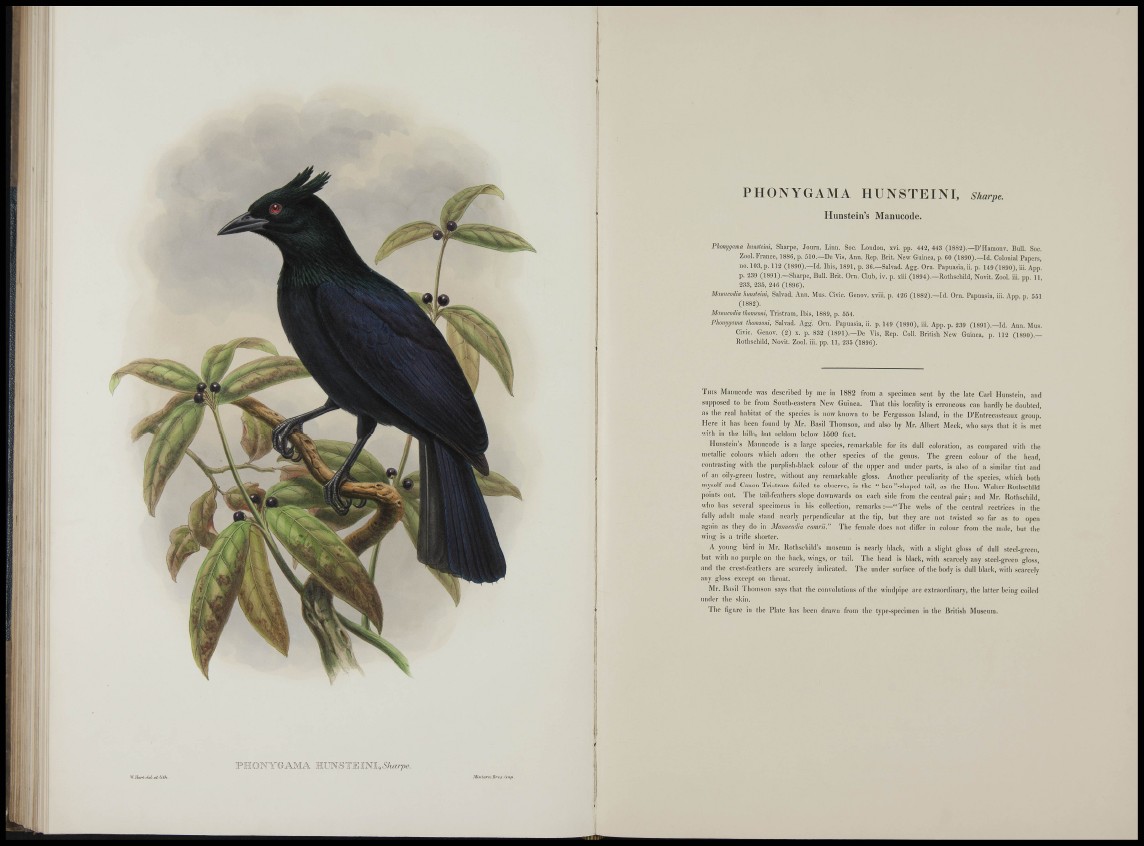
'GAMA HUNS TE 3NI , Sharpv.
If. «.ri f/o¿.eí Uth MuO-ertx^iirns • <n\p
l i t !
P H O N Y G A M A H U N S T E I N l , sharpe.
Hunsteiii's Manucode.
Phonygama Imnsteini, Sharpe, Journ. Linn. Soc. London, xyi. pp. 442, 443 (1882).—D'Hamonv. Bull. Soc.
Zool. France, 1880, p. 510.—De Vis, Ann. Rep. Brit. New Guinea, p. 60 (1890).—Id. Colonial Papers,
no. 103, p. 112 (1890).—Id. Ibis, I89I, p. 36.—Salvad. Agg. Orn. Papuasia, ii. p. 149 (1890) , iii. App.
p. 239 (1891).—Sharpe, Bull. Brit. Orn. Club, iv. p. xiii (1894).—Rothschild, Novit. Zool. iii. pp. 11,
2.'!3, 235, 246 (1896).
Manucodia hmsfeim, Salvad. Ann. Mus. Civic. Genov. xviii. p. 426 (1882).—Id. Orn. Papuasia, iii. App. p. 551
(1882).
Mamicoilia thomoni, Tristram, Ibis, 1889, p. 554.
Phonygama ihomsoni, Salvad. Agg. Orn. Papuasia, ii. p. 149 (1890), iii. App. p. 239 (1891).—Id. Ann. Mus.
Civic. Genov. (2) x. p. 832 (1891).—De Vis, Rep. Coll. British New Guinea, p. 112 (1890).—
Rothschild, Novit. Zool. iii. pp. 11, 235 (1896).
THIS Manucode was described l>y me ii] 1882 from a specimen sent by the late Carl Hunstciri, and
su])posed to be from South-eastern New Guinea. That this locality is erroneous can hardly he doubted,
as the real habitat of the species is now known to he Fergusson Island, in the D'Entrecasteaux group.
H e r e it has been found by Mr. Basil Tbomson, and also by Mr. Albert Meek, who says that it is met
with in the bills, but seldom below 1500 feet.
H u n s t c i n ' s Manucode is a large species, remarkable for its dull coloration, as compared with the
metallic colours which adorn the other species of the genus. The green colour of the bead,
c o n t r a s t i n g with the purplish-black colour of the upper and under parts, is also of a similar tint and
of an oily-green lustre, without any remarkable gloss. Another peculiarity of the species, wbicb both
myself and Canon Tristram failed to observe, is the " hen "-shaped tail, as the Hon. Walter Rothschild
|)oints out. The tail-feathers slope downwards on each side from the central pair; and Mr. Rothschild,
who has several specimens in his collection, remarks:—"The webs of the central rectrices ii] the
fully adult male stand nearly perpendicular at the tip, but they are not tivisted so far as to open
again as they do in A/anurorlia comrii." Tbe female does not differ ii] colour from the male, but the
wing is a trifle shorter.
A young bird in Mr. Rothschild's museum is nearly black, with a slight gloss of dull steel-green,
hut will] no purple on tbe back, wings, or tail. The head is black, with scarcely any steel-green gloss,
and the crest-feathers are scarcely indicated. The under surface of the body is dull black, with scarcely
any gloss except on throat.
Mr. Basil Thomson says ibat tbe convolutions of the windpipe are extraordinary, tbe latter being coiled
under the skin.
T b e (ignre in the Plate has been drawn from tiie type-specimen in tbe British Museum.